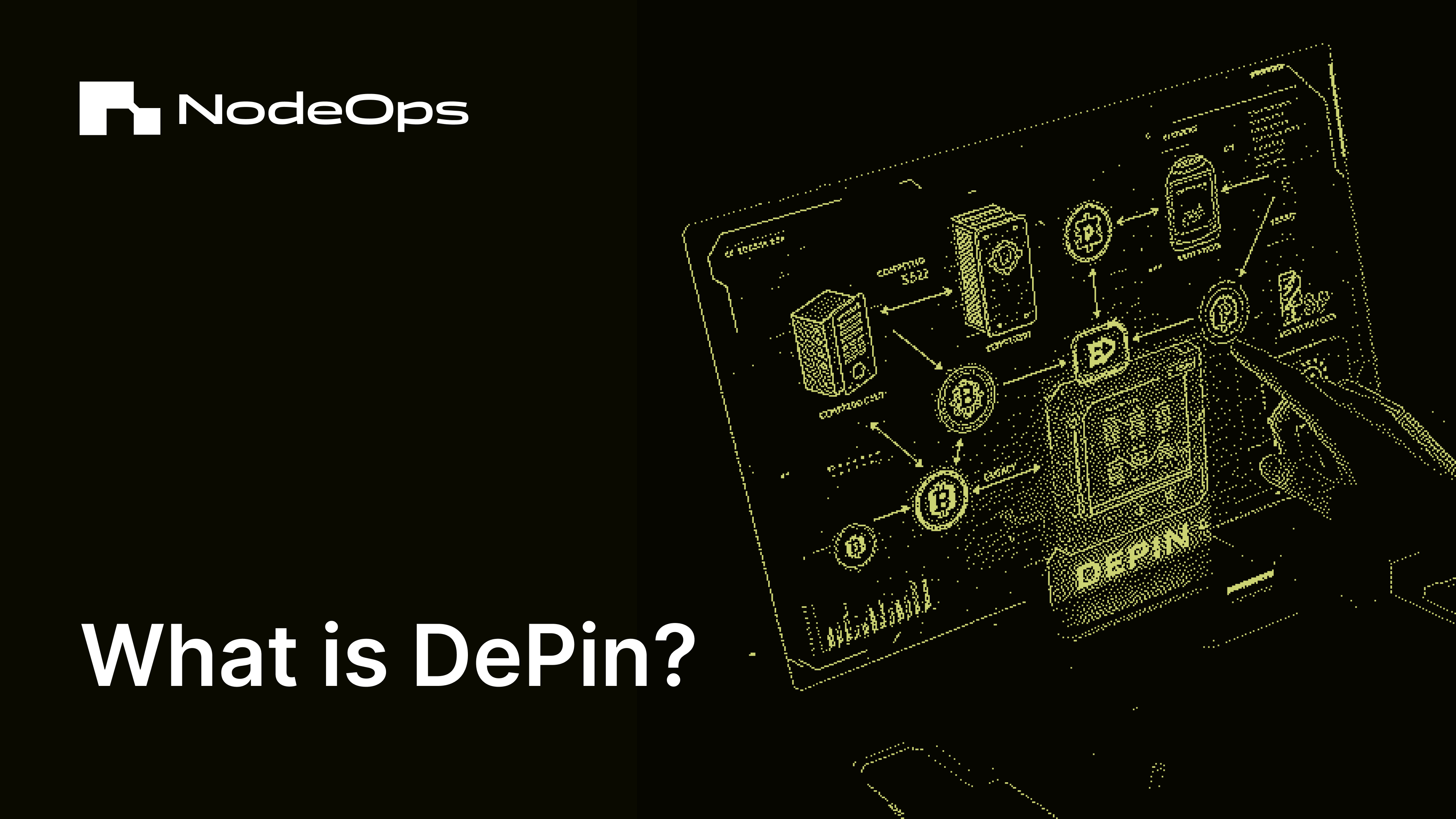What is DePIN?
 NodeOps
NodeOps
DePIN is a fundamentally revolutionary approach to infrastructure. It's also a reliable mechanism for ecosystem participants to earn crypto.
By leveraging blockchain technology and tokenization, DePIN redefines how we build, maintain, and scale the essential systems that power our world, from energy grids to wireless networks.
But what exactly is DePIN, and how massive is its potential market?
DePIN Overview
DePIN stands for Decentralized Physical Infrastructure Networks. It’s a concept where physical infrastructure/s are orchestrated by a decentralized network of participants who are incentivized through tokens.
Let’s start by double-clicking on the term “orchestrated”. A blockchain protocol acts as the orchestrator for DePIN projects. Now a blockchain is a large, slow, distributed database that is totally unsuited as a bottleneck to, say, your cloud compute. However, DePINs' services are unimpeded by the blockchain protocols that orchestrate them. What the protocol does is ensure that all the participants are aligned to behave in the best interests of the network by distributing incentives and enforcing disincentives automatically, with no central control.
Emerging use cases include:
Compute: Decentralized alternatives to centralized cloud compute and storage providers.
Wireless: Such as 5G networks, where decentralized nodes can help expand coverage and capacity.
IoT: Decentralized IoT networks allow devices to communicate directly with each other without centralized intermediaries, improving security and reducing latency.
Sensors: Collect real-time data through interconnected devices, providing insights into everything from traffic patterns to environmental conditions.
Identity: Decentralized identity solutions empower individuals to control their own digital identities, reducing reliance on centralized identity providers and enhancing privacy and security.
Energy: DePIN can create more resilient and efficient energy grids, offering an alternative to traditional energy monopolies
Logistics: Decentralized logistics networks streamline supply chain management, reducing costs and improving transparency and efficiency.
Under the traditional model, large corporations, such as energy companies or telecommunications giants, invest billions into developing and maintaining the infrastructure that powers our world. These companies also control the infrastructure, often leading to rising prices, inefficiencies, and centralization. DePIN, on the other hand, uses blockchain and tokenization to outsource the construction and upkeep of infrastructure to a decentralized network of contributors.
These contributors may be retail running specialized devices, such as under Hivemapper's (TAG) global mapping dashcam model, or Helium's (TAG) cellular and WiFi networks. Under some models, the service providers are professional providers such as Filecoin's (TAG) data centers or cloud infrastructure providers who provide their professional-grade facilities. Some models are a hybrid, such as NodeOps' Node-as-a-Service model, whereby NodeOps provides the professional node running services to enable license-holding retail customers to run Web3 protocol nodes.
Common to all of these is the incentivization model of DePIN. Participants, whether individuals or companies, are incentivized with tokens to help build and maintain these physical networks. This model is similar to the liquidity incentives used in decentralized finance (DeFi), yield farming, or move-to-earn platforms. A key economic difference is that DePIN focuses on physical infrastructure that provides real-world benefits rather than volatile digital financial systems.
Also common to most DePIN business models is that they apply a demand-side approach. Once the infrastructure is in place, the network attracts users who pay for services, which then incentivizes even more participants to contribute, creating a virtuous cycle of growth.
The factors that drive this incentivization include:
Improved network utility: As the provider network grows, so does the network’s capacity, performance, and coverage (whether that be geographic, functional, or both). This makes the network more valuable to users, further increasing demand and revenues.
Economies of scale: Operational overheads carried by the DePIN ecosystem often decrease due to economies of scale. Lower costs can then translate into higher profits for contributors or more competitive pricing for users.
Competitive advantage through decentralization: A larger participant base reduces reliance on any single provider. This benefits participants such as Web3 businesses that value decentralization over centralized alternatives.
The benefits of DePIN
DePIN brings efficiency, decentralization, and democratization to infrastructure. While there are unique advantages depending on the sector the DePIN supports, the main advantages common to all DePIN verticals include:
Faster deployment: Traditional infrastructure projects can take years, even decades, to build. With DePIN, networks can be bootstrapped much faster—factors of 10x faster—by leveraging decentralized contributions.
Cost efficiency: By spreading the cost of building infrastructure across a decentralized network, DePIN makes the process more cost-effective and, therefore, scalable
Localized & hyper-responsive: DePIN networks can be better tailored to specific local needs; supporting customized and agile infrastructure deployment.
Cross-jurisdictional scalability: The decentralized nature of DePIN means that infrastructure can be built and maintained across borders without requiring centralized approval or regulation.
Credible neutrality: DePIN networks are collectively owned and managed, making them more transparent and neutral than centralized alternatives.
Integration with DeFi: Blockchain's frictionless micropayments allow DePIN networks to integrate with decentralized finance systems--enabling seamless, automated transactions.
How big is the market?
The global market for physical infrastructure is massive. For comparison, the combined market cap of the top 10 cloud companies in 2023 exceeded $6 trillion.
The DePIN sector, as of 2024, has a market cap of over $50 billion across 350 tokens. Compare this to the report from Messari and EV3, in 2023, when the DePIN ecosystem held $20 billion in market cap and over $15 million in revenue, suggesting that anticipated growth is significant.
If DePIN captures even a small fraction of the traditional infrastructure market, it could open up trillions of dollars in value. Analysts predict that the sector could hit $3.5 trillion by 2028, driven by increasing demand for decentralized solutions in energy, data storage, and content delivery. As more consumers and businesses demand more resilient, scalable, and efficient infrastructure, the potential market for DePIN will continue to expand.
DePIN's Challenges
DePIN is a specialized technical industry, and each project faces several challenges they must overcome:
Technical Complexity: The teams responsible for integrating blockchain with physical infrastructure require a deep understanding of both scalability and security.
Regulatory Hurdles: DePIN projects often span both physical and digital domains, which can make compliance for some industries challenging.
Market Adoption: Competing against the large Web2 companies such as Amazon, Google, and Microsoft is a massive challenge. They have deep pockets and pre-established customer bases. DePIN projects must prove they can compete with these giants and offer tangible advantages out of the gate.
Dilution of Incentive Models: While token incentives are a powerful tool, they can be highly dilutive if not structured properly. The time it takes to build demand and real use cases could also be longer than anticipated, which might deter some investors.
The Flywheel Effect of DePIN
One of the most exciting aspects of DePIN is the bootstrapping effect it can natively build on. The potential of the flywheel effect is meaningful:
Out of the gate as supply side: Initially, DePIN networks rely on contributors—who are incentivized with tokens—to build out the infrastructure. In the nascent stages, this can include anyone from individual volunteers to large corporations (this is the model that NodeOps Network applies to our Node Compute Marketplace).
Demand side: Once the network is established, users start to pay for the services, creating a revenue stream for the ecosystem participants.
Growth cycle: An increase in new users drives demand for the token, which in turn encourages more contributors to join, further expanding the network. This drives up the value of both the network and the token.
The power of decentralized blockchains is that they allow tokenization to provide a permissionless and trustless way to bootstrap global networks: creating a virtuous cycle that drives network growth and value.
DePIN’s Future Outlook
As of 2024, the DePIN sector is at an exciting crossroads. It has already surpassed a $32 billion market cap, and the interest from venture capitalists is growing by the day. The upcoming years will be pivotal for the sector as more and more DePIN projects go live and show the real-world applications of decentralized infrastructure.
DePIN is an emergent and rapidly growing Web3 sector disrupting how we think about infrastructure. Successful projects like Filecoin and Helium have already demonstrated that the concept is sound and has real-world applicability and uptake. While there are challenges, here at NodeOps Network we are working to combat those and believe that the combination of blockchain and tokenization could be the key to building more resilient, scalable, and cost-effective infrastructure. As the market matures, we could see DePIN capture a significant slice of the multi-trillion-dollar global infrastructure market, making it a space worth watching closely in the coming years.
Disclaimer: NodeOps Network has skin in the game. NodeOps Network is the leading chain-agnostic, AI-powered DePIN Orchestration layer for general-purpose compute, economically secured by Autonomous Verifiable Services (AVS).
NodeOps Network’s service-agnostic Compute Marketplace supports multiple verticals, from low-demand node operations to high-demand AI, ML, and data modeling. Enforcing integrity with its Autonomous Verifiable Services (AVS), the marketplace ensures that compute providers and consumers benefit from verifiable, high-availability, economically secure infrastructure. It allows anyone to provide, purchase, deploy, and manage verifiable computing.
Want to get involved?
NodeOps Network’s incentivized Testnet is live. Join a quest and experience our decentralized compute marketplace.
Subscribe to my newsletter
Read articles from NodeOps directly inside your inbox. Subscribe to the newsletter, and don't miss out.
Written by
